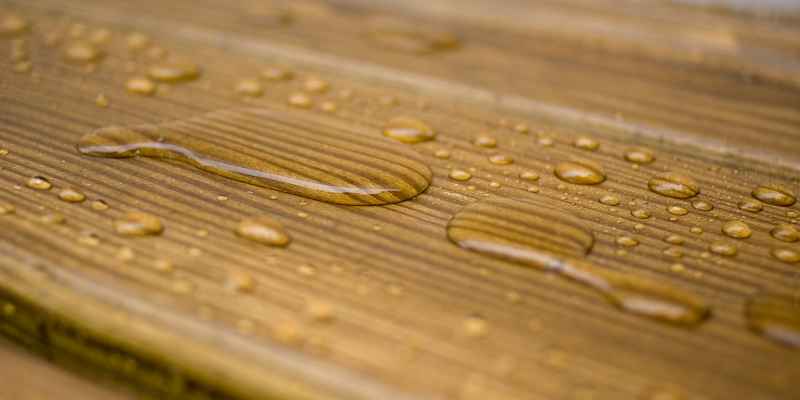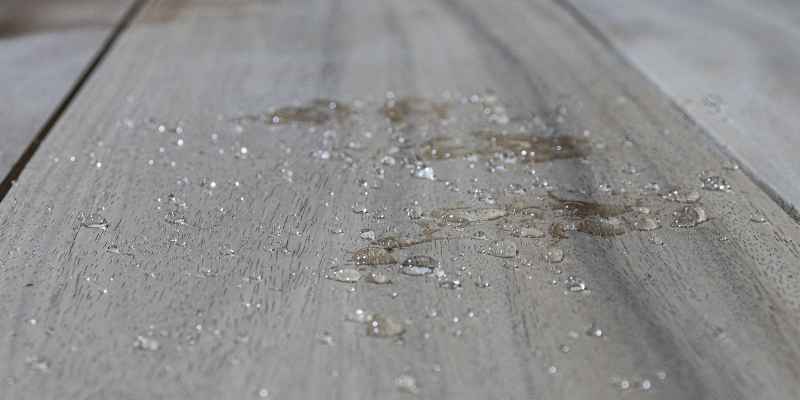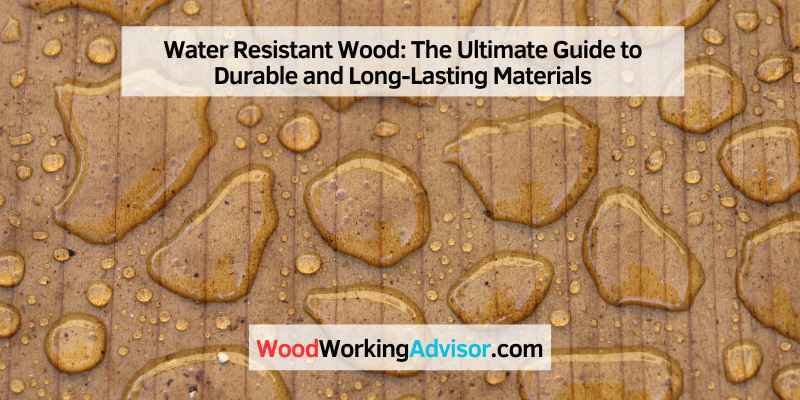Water-resistant wood is treated to repel water and resist rot, making it suitable for outdoor use. It is a durable and weather-resistant material commonly used in outdoor furniture and construction.
Water-resistant wood undergoes a treatment process to enhance its ability to withstand moisture and weathering, extending its lifespan and usability. This type of wood is preferred for applications where exposure to water and outdoor elements is inevitable, as it maintains its strength and appearance over time.
The treatment process typically involves applying sealants or coatings that create a protective barrier against moisture, preventing deterioration and decay. With its ability to withstand water, water-resistant wood is a practical and long-lasting choice for various outdoor projects and products.
Types Of Water-resistant Wood
When it comes to water-resistant wood, there are several types to choose from. Understanding the characteristics of each type can help you make an informed decision when selecting the right wood for your outdoor projects. Let’s take a closer look at some of the most popular types of water-resistant wood that are commonly used in construction and outdoor furniture.
Tropical Hardwood
Tropical hardwood, such as teak and ipe, is renowned for its natural resistance to water, making it an excellent choice for outdoor applications. These woods contain natural oils and dense fibers that repel water, preventing moisture-related issues such as rot and decay. Their durability and low maintenance make them ideal for decking, patio furniture, and boat building.
Cedar
Cedar is another popular choice for outdoor projects due to its natural water-repelling properties. The natural oils in cedar wood act as a barrier against moisture, making it resistant to rot and decay. Additionally, cedar has a distinct aroma that deters insects, making it an excellent option for outdoor furniture and siding.
Redwood
Redwood is prized for its natural resistance to decay and insect damage, making it a sought-after material for outdoor structures. The high tannin content in redwood provides protection against rot, ensuring longevity in wet environments. Its rich, reddish-brown color and natural beauty make it a favored choice for decks, fences, and garden furniture.

Properties Of Water-resistant Wood
Wood with natural oils and extractives boasts enhanced water resistance.
High Density
High-density wood is naturally more resilient against water infiltration.
Resistance To Decay And Rot
Wood’s innate resistance to decay and rot aids in its water-resistant properties.
Benefits Of Water-resistant Wood
Water-resistant wood is an excellent choice for various indoor and outdoor applications, as it provides numerous benefits that make it a preferred option for homeowners and construction professionals alike. From enhanced durability to low maintenance requirements and aesthetic appeal, water-resistant wood truly stands out. Let’s explore these benefits in more detail:
Durability
Water-resistant wood is known for its exceptional durability, making it an ideal choice for areas exposed to moisture and humidity. Unlike regular wood which can warp, rot, or decay when exposed to water, water-resistant wood stands strong against these common issues. Its unique composition and protective coatings ensure that it remains structurally intact and free from damage caused by water, making it a long-lasting investment for any project.
Low Maintenance
One of the key advantages of water-resistant wood is its low maintenance requirements. Regular wood often requires frequent sealing, staining, or painting to protect it from water damage and maintain its appearance. However, water-resistant wood is specifically designed to resist water penetration and damage, reducing the need for constant maintenance. With water-resistant wood, you can enjoy a beautiful and functional space without the hassle of regular upkeep.
Aesthetic Appeal
Water-resistant wood doesn’t only offer practical benefits but also contributes to the overall aesthetic appeal of any space. With its natural beauty and timeless charm, water-resistant wood adds a touch of elegance and sophistication to indoor and outdoor areas. Whether you’re looking to create a cozy deck, stylish furniture, or a stunning feature wall, water-resistant wood provides a wide range of design options to suit your preferences and enhance the visual appeal of your space.
Best Uses For Water-resistant Wood
Water-resistant wood is a versatile option for a variety of outdoor projects. Its ability to withstand moisture makes it ideal for use in outdoor furniture, decking, and siding or cladding. Whether you’re looking to create a comfortable outdoor seating area, build a durable deck, or enhance the exterior of your home, water-resistant wood is an excellent choice. Let’s explore the best uses for water-resistant wood in more detail.
Outdoor Furniture
Water-resistant wood is perfect for creating outdoor furniture that can withstand the elements. Whether you’re considering a cozy patio set or a rugged picnic table, this type of wood is an excellent option. Its resistance to water damage ensures that your furniture will maintain its beauty and functionality for years to come. Additionally, the natural aesthetics of water-resistant wood add a touch of rustic charm to any outdoor space. From benches to lounge chairs, water-resistant wood is a reliable and stylish choice for your outdoor furniture needs.
Decking
When it comes to building a deck that can endure exposure to rain, snow, and humidity, water-resistant wood is the way to go. Its ability to repel water and resist decay makes it an ideal material for decking. With its natural strength and durability, water-resistant wood ensures your deck will stand up to the test of time while maintaining its attractive appearance. Whether you’re planning a small deck or a larger, multi-level structure, water-resistant wood provides the durability and reliability you need for a long-lasting outdoor space.
Siding And Cladding
Water-resistant wood is also an excellent choice for siding and cladding on the exterior of your home. Its ability to repel moisture protects your home from damage caused by water infiltration. Additionally, water-resistant wood provides insulation and soundproofing properties, enhancing the overall quality and comfort of your living space. With a variety of wood choices available, you can select the perfect water-resistant option to complement your home’s architectural style and add a touch of natural beauty to its exterior.
Treatment And Maintenance
When it comes to water-resistant wood, proper treatment and maintenance are essential in preserving its durability and aesthetic appeal.
Sealing And Staining
Sealing: Apply sealant regularly to protect the wood from moisture infiltration.
Staining: Use a quality stain to enhance the wood’s natural beauty while adding an extra layer of protection.
Regular Cleaning
Regularly clean the wood surfaces with mild soap and water to remove dirt and debris.
Avoid using harsh chemicals that can damage the wood finishes.
Preventive Measures
-
Use coasters and placemats to prevent water stains on wood surfaces.
-
Regularly check for any cracks or damage and repair promptly.
-
Avoid placing hot objects directly on the wood to prevent heat damage.
Environmental Impact
When it comes to choosing the right wood for outdoor projects, it’s essential to consider the environmental impact. One factor to consider is the water resistance of the wood, as it can determine the durability and lifespan of your project. However, it’s also crucial to ensure that the wood you choose is sustainable and eco-friendly. This section will explore the environmental impact of water-resistant wood and highlight sustainable practices, eco-friendly options, and recycling and reuse.
Sustainability Practices
Sustainability practices play a vital role in minimizing the environmental impact of the wood industry. Companies that prioritize sustainability ensure that their wood is sourced from responsibly managed forests. They follow strict guidelines and certifications, such as Forest Stewardship Council (FSC), to guarantee that the wood is harvested in an environmentally-friendly manner.
These practices include replanting trees to ensure long-term forest health, reducing carbon emissions during the manufacturing process, and implementing measures to protect wildlife habitats and biodiversity. By choosing water-resistant wood from companies that implement sustainable practices, you contribute to the preservation of our forests and ecosystems.
Eco-friendly Options
When looking for eco-friendly options, it’s important to consider alternatives to traditional pressure-treated or chemically-treated woods. These options provide water resistance while minimizing the environmental impact. Some popular eco-friendly options include wood species naturally resistant to water, such as cedar and redwood.
These woods are known for their durability, natural resistance to decay, and ability to withstand moisture. Choosing these eco-friendly options reduces the need for chemical treatments, thereby reducing potential harm to the environment.
Recycling And Reuse
In addition to sustainable practices and eco-friendly options, recycling and reuse also contribute to minimizing the environmental impact of water-resistant wood. Many companies now offer recycled or repurposed wood products that are water-resistant and meet the same standards as new wood.
Recycling and reusing wood help reduce waste and preserve natural resources. By opting for these options, you actively participate in the circular economy, where materials are kept in use for as long as possible, minimizing carbon emissions and reducing the demand for new resources.

Considerations Before Purchase
Before purchasing water-resistant wood, it is important to consider its durability, maintenance requirements, and cost-effectiveness. Additionally, evaluate its resistance to moisture, rot, and pests, ensuring it will suit your specific needs.
Before investing in water-resistant wood, there are several crucial factors to consider to ensure that you make the right choice for your specific needs. Take into account your budget, the climate and weather conditions in your area, and the availability of different types of water-resistant wood.
Budget
The most important factor to consider before purchasing water-resistant wood is your budget. Different types of water-resistant wood vary in cost, and it’s essential to determine how much you are willing to spend and what level of quality you require.
Climate and Weather Conditions
Another key consideration is your local climate and weather conditions. Understanding the level of exposure to moisture, humidity, and extreme temperatures in your area will help you select the most suitable water-resistant wood that can withstand these environmental factors.
Availability
The availability of water-resistant wood in your region is also a crucial consideration. Some types of water-resistant wood may be more readily accessible than others, and it’s important to choose a material that is easily obtainable for your project.
By considering these factors, you can make an informed decision when purchasing water-resistant wood that meets your needs and provides long-lasting durability in challenging environmental conditions.
Future Trends And Innovations
Water Resistant Wood is witnessing exciting future trends and innovations that are revolutionizing the industry. Let’s delve into the latest advancements shaping the use of water-resistant wood.
Improvements In Water-resistance
Wood manufacturers are developing enhanced treatment methods to improve the water-resistance of wood, making it more durable and long-lasting.
New Wood Species Exploration
Exploration of innovative wood species that naturally possess water-resistant properties is on the rise, expanding the options available for construction projects.
Technological Advancements
Technological innovations such as nanotechnology coatings are being utilized to enhance the water-resistance of wood, providing improved protection against moisture damage.
Frequently Asked Questions For Water Resistant Wood
Is Water Resistant Wood Suitable For Outdoor Furniture?
Yes, water-resistant wood is ideal for outdoor furniture as it can withstand exposure to moisture and humidity, prolonging its lifespan and maintaining its structural integrity. It is less prone to warping, rotting, or mold growth compared to non-water-resistant alternatives.
How Can Water Resistant Wood Be Maintained?
Regularly apply a protective sealant or finish to the wood to enhance its water resistance and prevent damage from environmental factors. Keep the wood clean and dry, avoiding prolonged exposure to moisture. Periodic inspections and reapplications of sealants can help maintain the wood’s water resistance.
What Are Some Common Types Of Water-resistant Wood?
Cedar, redwood, teak, and cypress are commonly used water-resistant wood types that are naturally resistant to decay and moisture. These woods have inherent properties that make them suitable for outdoor use without requiring extensive chemical treatments for water resistance.
Can Water Resistant Wood Be Stained Or Painted?
Yes, water-resistant wood can be stained or painted to enhance its appearance and provide additional protection against water damage and UV rays. Use exterior-grade stains or paints designed for use on outdoor wood surfaces to ensure durability and longevity of the finish.
Conclusion
Water-resistant wood is a versatile and durable choice for outdoor projects. Its natural properties provide long-lasting protection against moisture, rot, and decay. Consider using water-resistant wood for your next project to ensure a beautiful and sturdy outcome that withstands the test of time.

